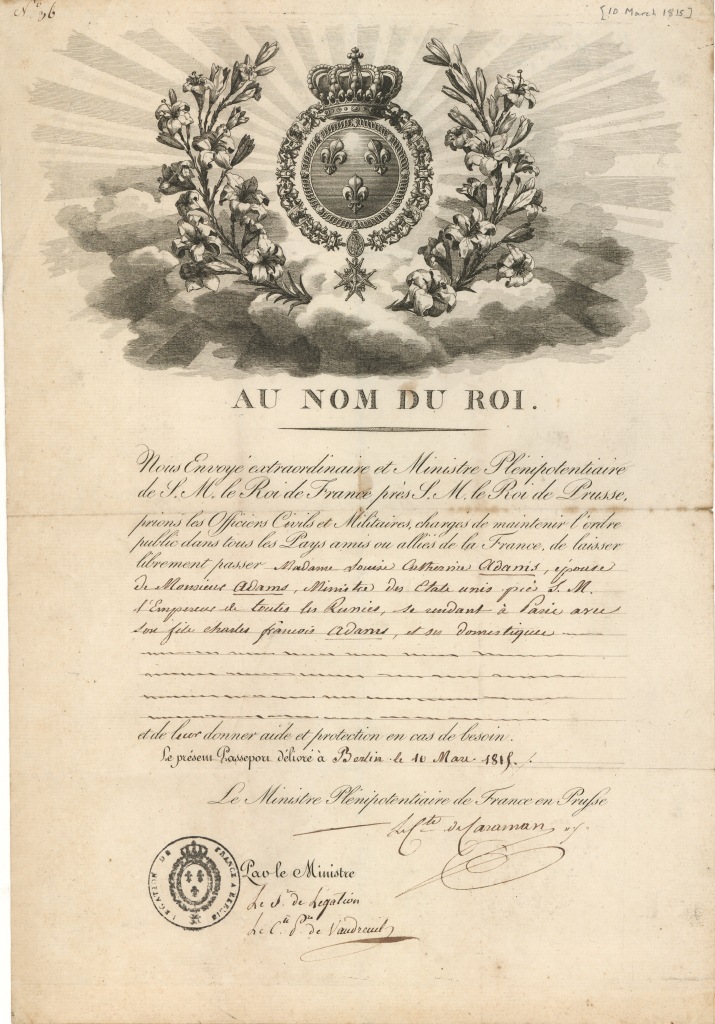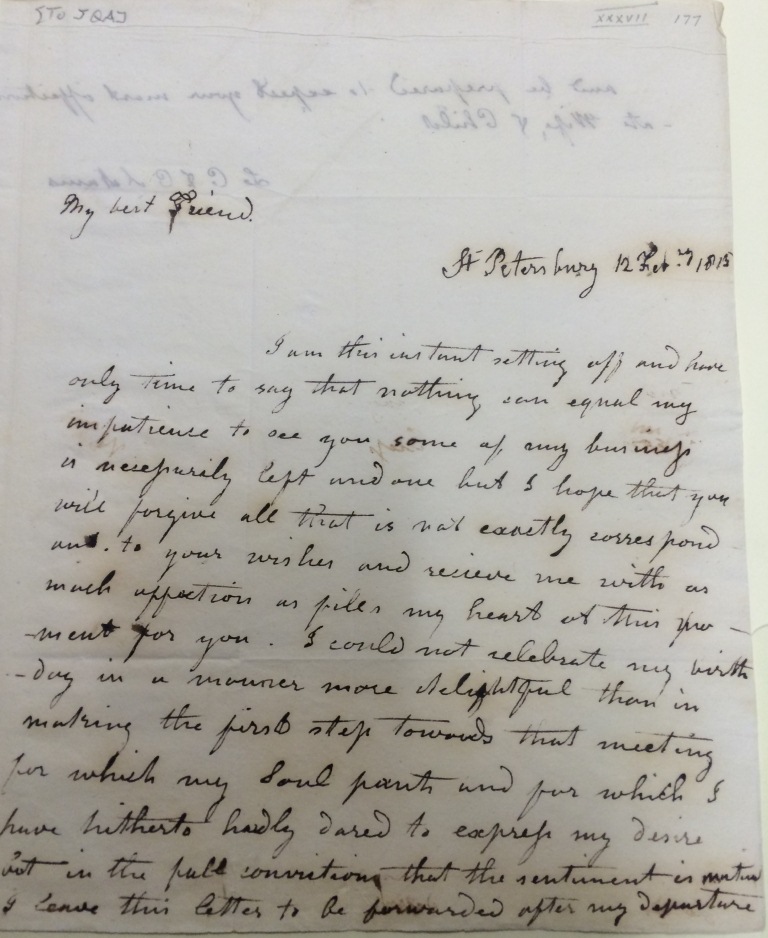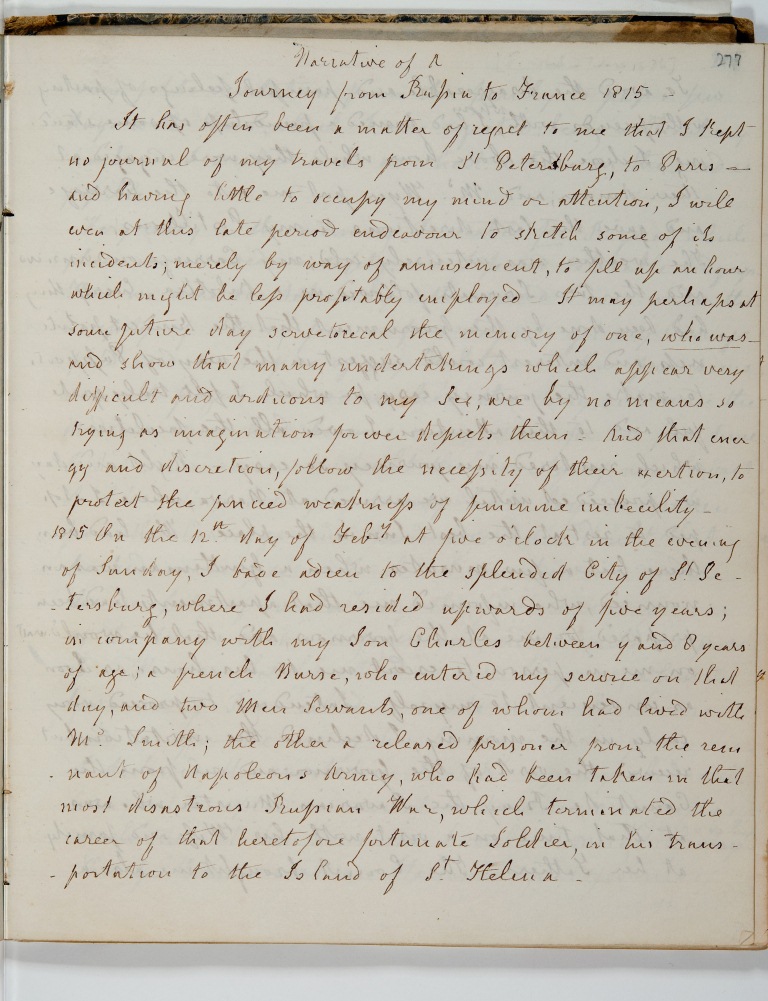By Amanda A. Mathews, Adams Papers
 This month marks the 200th Anniversary of Louisa Catherine Adams’s six-week and nearly 2,000-mile trip from St. Petersburg, Russia, to Paris, France. Travelling by carriage across a war-torn Europe and in the midst of Napoleon’s Hundred Days after his escape from his exile on Elba, trying to reach her husband, John Quincy, who, negotiating an end to the War of 1812 in Ghent, she had not seen for a year, Louisa’s story is an amazing one.
This month marks the 200th Anniversary of Louisa Catherine Adams’s six-week and nearly 2,000-mile trip from St. Petersburg, Russia, to Paris, France. Travelling by carriage across a war-torn Europe and in the midst of Napoleon’s Hundred Days after his escape from his exile on Elba, trying to reach her husband, John Quincy, who, negotiating an end to the War of 1812 in Ghent, she had not seen for a year, Louisa’s story is an amazing one.
Louisa’s journey began on Sunday, February 12, 1815—her fortieth birthday—setting out with her seven-year-old son, Charles Francis, and a few servants she didn’t know if she could entirely trust. Despite what she knew would be an arduous and dangerous journey, Louisa started out in hope and expectation as she wrote to her husband:
I am this instant setting off and have only time to say that nothing can equal my impatience to see you some of my business is necessarily left undone but I hope that you will forgive all that is not exactly correspondant to your wishes and recieve me with as much affection as fills my heart at this moment for you. I could not celebrate my birthday in a manner more delightful than in making the first step towards that meeting for which my Soul pants and for which I have hitherto hardly dared to express my desire but in the full conviction that the sentiment is mutual.
During her trip, Louisa faced poor lodgings, broken down and  lost carriages, and news of murders on the roads she was travelling. Still she recalled the scenes she passed in her retrospective Narrative of a Journey from Russia to France: “The Season of the year at which I travelled; when Earth was chained in her dazzling, brittle but solid fetters of Ice, did not admit of flourishing description, of verdant fields, or paths through flowery glebes; but the ways were rendered deeply interesting by the fearful remnants of mens fierry and vindictive passions; passively witnessing to tales of blood, and woes.” Finally, as she approached Paris, a unit of soldiers loyal to Napoleon, seeing that her carriage was of Russian origin, threatened to seize and kill them. Louisa, fluent in French, was able to show them her passport and explain that she was an American and diplomatically shouted, “Vive Napoleon!” to appease the troops and guarantee her safe passage. At last, late in the evening of March 23, a “delighted” John Quincy reunited with his wife and child.
lost carriages, and news of murders on the roads she was travelling. Still she recalled the scenes she passed in her retrospective Narrative of a Journey from Russia to France: “The Season of the year at which I travelled; when Earth was chained in her dazzling, brittle but solid fetters of Ice, did not admit of flourishing description, of verdant fields, or paths through flowery glebes; but the ways were rendered deeply interesting by the fearful remnants of mens fierry and vindictive passions; passively witnessing to tales of blood, and woes.” Finally, as she approached Paris, a unit of soldiers loyal to Napoleon, seeing that her carriage was of Russian origin, threatened to seize and kill them. Louisa, fluent in French, was able to show them her passport and explain that she was an American and diplomatically shouted, “Vive Napoleon!” to appease the troops and guarantee her safe passage. At last, late in the evening of March 23, a “delighted” John Quincy reunited with his wife and child.
You can read more of Louisa’s recollections in A Traveled First Lady: Writings of Louisa Catherine Adams.

Images: LCA to JQA, 12 Feb. 1815; LCA’s French Passport issued 10 March 1815; and the first page of LCA’s Narrative of a Journey

